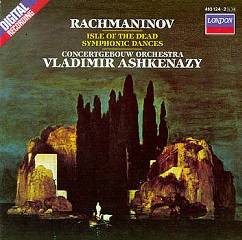Sergei Rachmaninov: Isle of the Dead - Symphonic Dances (1984)
Sergei Rachmaninov: Isle of the Dead - Symphonic Dances (1984)

Symphonic Poem “Isle of the Dead”, Op. 29 I. Die Toteninsel Symphonic Dances II. Symphonische Taenze – Non allegro III. Symphonische Taenze – Andante con moto (Tempo di valse) IV. Symphonische Taenze – Lento assai – Allegro vivace Royal Concertgebouw Orchestra Vladimir Ashkenazy (Conductor)
Here was a composer who lived from the very end of the Romantic era through the core modernist period, a stretch of human history which endured tremendous change and tumult. The tone poem The Isle of the Dead was inspired by Arnold Böcklin's 1886 painting of the same name, which Rachmaninov saw in Paris in 1907. Written in 1909, it is a relatively early work, but already contained something of the dark Russian spirit which still tints Rachmaninov's last major orchestral work, the Symphonic Dances of 1940.
The 21-minute Isle of the Dead begins with the lowest range of the orchestra tolling ominously, like a slow funeral march, reminiscent of the opening of the Second Piano Concerto. As the strings rise to the surface, the gently lapping 5/8 rhythm (the waves, the rocking boat) breathes with determination, as relentless as Holst's Mars, as dark as Sibelius' Tapiola.
In effect a long crescendo, the boat approaches the Isle, passing through the mists that separate earthly life and the realm of the dead. Then comes the yearning desire for the rest that death grants, a section of sweet melodic outpourings. After the climax of violent pounding chords, the strings begin [15'56"] to eerily chant the Dies Irae ("Day of Wrath" from the Latin Mass) motif, made all the more creepy by scoring it tremolo. Suddenly - bliss in the form of woodwind, resignation of a wind chorale. His task completed, the grim boatman of death begins his departure. The undulating waves return, slowly, ever so slowly, sending us away from the Isle. The music fades, ends.
Rachmaninov originally thought of naming the three movements of the Symphonic Dances "Midday", "Twilight" and "Midnight", but decided against it to prevent misinterpretation of the music. Even then, these are not so much dances of the ballet variety, but truly symphonic dances which celebrate the dynamic rhythms of the art of moving the human body. Indeed, the opening of the first movement, the Non Allegro, virtually defies you to not move along with its insistent, wrenching TUM-TUM-TUM! rhythm (I am badly hooked on this theme). There is also something of the anxiety of hectic urban life in the piece, perhaps an effect of the composer's last decades of life in America.
This is a symphonic masterpiece of orchestration: flourishing trumpets, hollering clarinets, swirling flutes, marching strings, nostalgic saxophone, singing piano, booming tuba, growling basses, whooping horns and chopping tambourines, plus harp, xylophone, cymbals all. Phew! It also exists as a fascinating transcription for two pianos (available on Hyperion CDA66654 or Double Decca 444 845-2) and I would imagine that it must be a wonderful piece to conduct too. Ashkenazy and the Concertgebouw demonstrate this with a gripping performance throughout.
Rachmaninov's music is never without the broad, melancholic melody, which is present in all three movements. Many distinct moods and interesting details abound in the score, which is coloured by additional instruments such as the saxophone and piano, as well as muted trumpets in the waltz. The waltz (Andante con moto - Tempo di valse) is a finely moulded piece, at once nostalgic, serene with just the slightest hint of the macabre.
The final movement, the Lento assai - Allegro vivace is highly characteristic of Spanish dance, with its short and quick themes, shatters of tambourine, trumpet fanfares and dramatism. Tubular bells and harps are also heard here, as is the doom-laden Dies Irae motif (which is in fact present in nearly all of Rachmaninov's works). Towards the end, xylophone and snare drum lead the frenzy of strings, hurling the Dances to its crashing conclusion.
Both pieces offer something expressive for the Romantically inclined, as well as food for dark thoughts. The late Christopher Palmer provides a fine 2-page essay that poetically introduces the works, while Ashkenazy and the Concertgebouw perform with startling conviction, reproduced in vivid Decca sound. Rachmaninov (above left) may not have been able to "cast out the old way" or "acquire the new", but that didn't prevent him from making good what he could do. --- Chia Han-Leon, inkpot.com
download: uploaded yandex 4shared mediafire solidfiles mega filecloudio nornar anonfiles ziddu
Zmieniony (Niedziela, 30 Marzec 2014 21:13)








